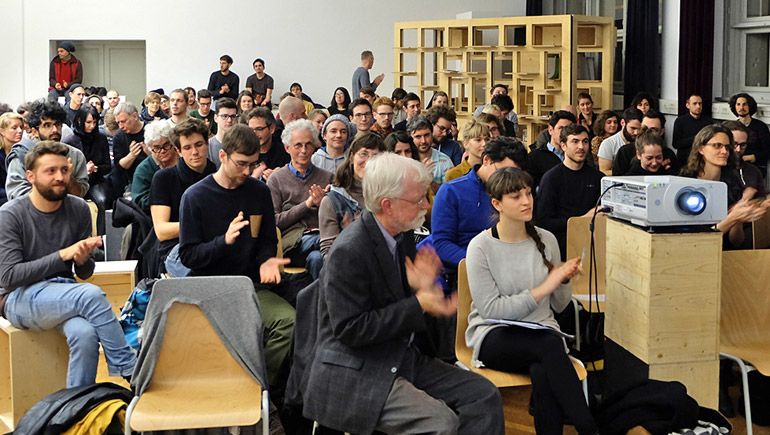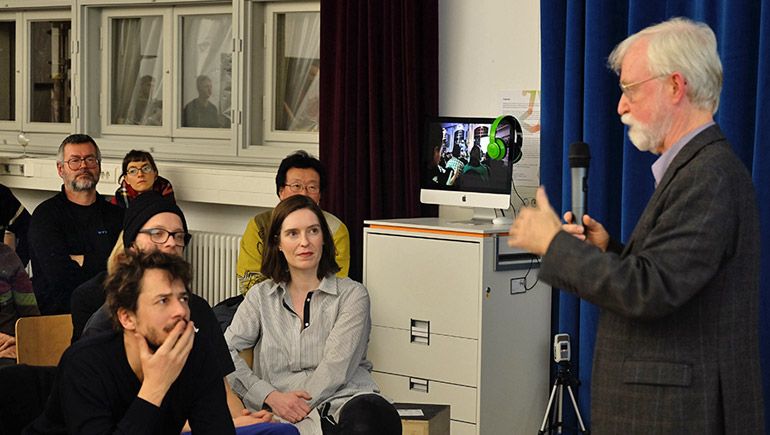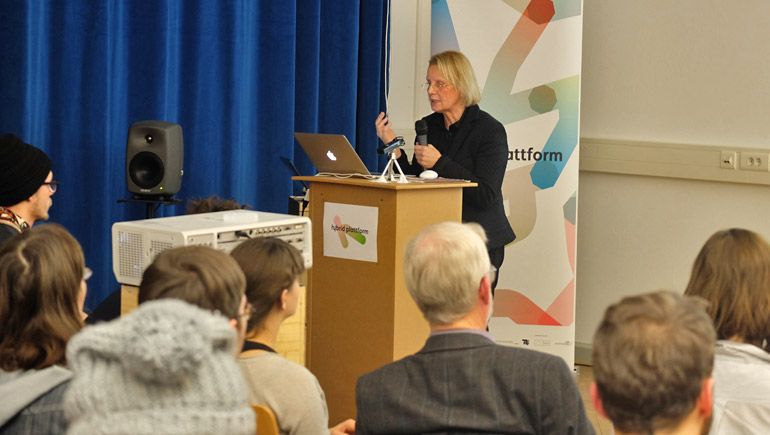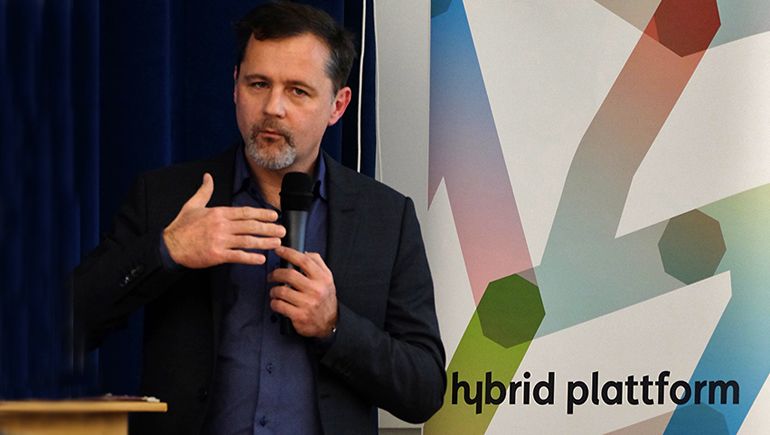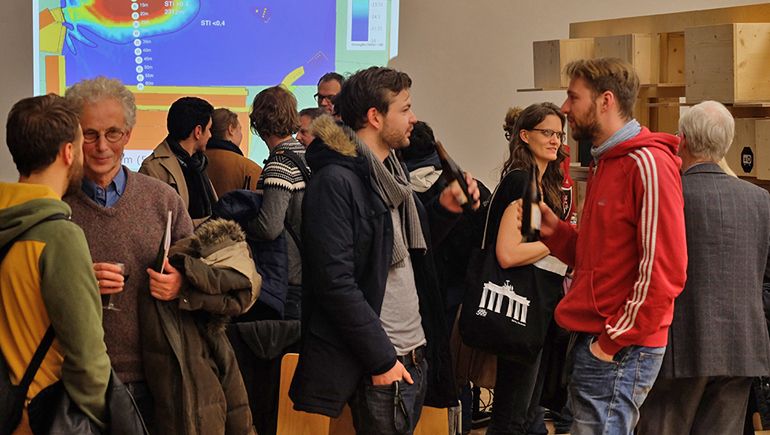What we see tends to be rather obvious, what we hear in comparison is far more subtle. Auditive perception deeply affects us regarding spontaneous moods or behavior as well as comprehensive aspects on a sociocultural level. The way we connect and interact with our environment can be understood by what and how we hear. So how do our presence and actions change or shape sound? Are we able to listen, carefully and aware?
“Soundscape” is a holistic approach that tries to face these topics in a flexible manner. It stretches between cultural-scientific and artistic concepts in exploring acoustic environments as a whole: the sound of nature, the technological noise of machinery, the hum of civilization, its effect on people and its historic transformation are documented, discussed and artistically translated. The 19th Hybrid Talks turned towards this topic and presented three researchers who explained the significance of “soundscape” within their work and thus its multidisciplinary potential.
Prof. Dr. Barry Truax, one of the founding fathers of the soundscape concept, held the first lecture. When the concept of soundscape originated in the 1970ies and as a founding member of the “World Soundscape Project”, the Canadian composer and sound-researcher co-defined the term to describe scientific and artistic ideas. Currently Truax is holding the Edgard Varèse Guest Professorship of the DAAD in the Audio Communication Group at the TU Berlin. The first Hybrid Event was dedicated to his compositional work and acknowledged the interdisciplinary approach of the soundscape concept. In his presentation “The Soundscape Concept and the Acoustic Community”, Traux gave a brief overview of soundscapes regarding its basic principles and its developments, describing the duality between objectivity and subjectivity as a permanent driving force. Whereas acoustic physics analyze sound as a transfer of energy, that can be measured and objectified, the influence of communication theory lead to a sociocultural perspective on sound, laying the foundations of soundscape as a scientific discipline. Being a psychological individual in steady exchange with a sounding world, the listener moved into the center of attention. He had to be taught to listen carefully and actively in order to become aware of his auditive surrounding in all its consequences. This paradigmatic change also caused criticism: how can a scientific, sociological concept that strives for general validity, be developed if sound is fully subjective? Regarding this problem, the early concept of soundscape was accused to be more prescriptive than descriptive, ignoring the need of scientific verification. With this in mind, Truax described the laying of a middle ground between these opposite viewpoints as a central aspect of his own work. Sound as a physical phenomenon is to be intertwined with its sociocultural context, which always is ambivalent and utterly complex due to the mediated subjectivity within communication. Sound may be acoustic energy, but it also carries meaning. It affects people.
Prof. Dr. Brigitte Schulte-Fortkamp is head of the Psychoacoustics, Noise Perception and Noise Effects Group at the TU Berlin. The concept of soundscape was introduced by Schulte-Fortkamp in the field of community noise and also sound design by the end of the 1990ies. Her contribution “Perception as the Constituent in Sound Design – the Soundscape of a Car” focused on recent psychoacoustic aspects of soundscapes in electric vehicles. She presented a pilot study, in which ten drivers where asked to describe their qualitative perception of different designs of an electric car’s driving sound, ranging from the sound of a combustion engine, to the raw sound of the electric engine and finally to a fully synthetic sound-concept. It turned out that a well implemented adaption of loudness according to the driving situation is an important factor – even if there’s a need for quite driving, acoustic feedback is requested. Here, Schulte-Fortkamp linked her talk to Truax’ presentation: the research design of the study, influenced by the idea of soundscape, included qualitative methods, considered the participants’ subjectivity and pointed out the importance of perception. According to her research results, the target consumer should be involved in the auditive shaping of the form and function of new technology.
Prof. Dr. Stefan Weinzierl, head of the Audio Communication Group of the TU Berlin, gave the last presentation of the evening on “Auralization as Acoustic Re-enactment of Historical Environments”. With examples of two recent projects, he explained how soundscapes that seem lost and forgotten by history can be digitally simulated and thus virtually brought back into life. Using information about the geometry of a room and the capability of its walls to absorb sound, researchers are able to digitally reconstruct the space and deduce its reflection patterns. With the resulting database of binaural impulse responses, that describe the transfer paths of sound within the virtual room, every recording can be edited to sound like it was actually played here. With the help of this technology researchers were able to simulate a string quartet playing in several historic concert halls, including the Gewandhaus in Leipzig, one of the first famous concert halls in Germany. Moreover, these simulations can be compared, allowing insights into performance practice and sound aesthetic of their epochs. Another project in cooperation with archeologists from the Humboldt-Universität zu Berlin focuses on a time period even longer ago. Here, the soundscape of the Forum Romanum from ancient Rome has been digitally reconstructed according to the square's design in 200 BC, 150 BC and 50 BC. The researchers are interested in how the speeches in this legendary site might have sounded. How far could a speaker be heard and how many people could be reached? The digital acoustic reconstruction delivers answers: 30 meters, appr. 1,200 people.
After this last talk, the speakers and the audience came together for further questions, discussions and several drinks. Regarding the number of guests, the 19th Hybrid Talks were a striking success. Every last chair, table and everything else you can sit on was occupied. Berlin is a city of sound, with its many concert venues and the techno tracks dropping in the clubs, with its streets full of noisy life and the constant humming of the subways. Without a doubt, one center of this urban soundscape is the Campus Charlottenburg, where a lively scientific and artistic scene gathers around their topic of interest: sound.
– Marten
Radio interviews (in German language) in the context of the Hybrid Talks “Soundscape”
- Deutschlandradio Kultur, Kompressor, 01/14/2016
interview with Prof. Dr. Stefan Weinzierl on the concept of soundscape and the Hybrid Talks:
“Maschinenlärm und Naturgeräusche als Kunst” - Inforadio rbb, WissensWerte, 02/03/2016
interview with Prof. Dr. Brigitte Schulte-Fortkamp on her research project presented at the Hybrid Talks:
“Wie sollen Elektroautos klingen?”
Did you miss the XIX Hybrid Talks? Listen to them here.

